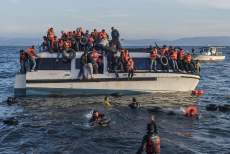
Over the past year the plight of refugees has come to be recognised as one of the toughest challenges facing the world over the coming decades and with good reason. Amnesty International, a global non-governmental organisation which fights against human rights abuses, has said in one report that this is the worst refugee crisis humanity has faced since the Second World War 70 years ago. In this same paper, Amnesty International’s secretary general, Salil Shetty said:
“We are witnessing the worst refugee crisis of our era, with millions of women, men and children struggling to survive amidst brutal wars, networks of people traffickers and governments who pursue selfish political interests…”
This startling claim is strongly backed up by the statistics; according to the United Nations High Commissioner for Refugees (UNHCR) there were nearly 60 million people living forcibly displaced in the world by the end of 2014. Of this figure around 20 million of those people were refugees, 1.8 million were asylum seekers (the name given to refugees who have been forced to leave their home countries but are applying for refuge in another country), whilst 38 million were internally displaced persons (people forced to leave their homes but remain in their own country). In this same year only 127,000 refugees returned to their place of origin.
Much of the recent press attention has been on refugees from Syria, who have had to leave their homes due to the brutal civil war which has been raging in the country for nearly four years now and shows no sign of ending any time soon. A country which has a population of 17million, Syria contains the largest number of internally displaced persons in the world at 7.6 million, over a third of its entire population. Additionally, by the end of 2014 Syrian refugees were the largest refugee group of any one country, numbering almost 3.9 million. Most of these people have fled to neighbouring countries, such as Lebanon and Turkey, between them hosting around 3.4 million displaced Syrians.
However, whilst much of Europe’s attention has been on Syrian refugees, since they have started to come across from Turkey and elsewhere in the Mediterranean into Greece, Spain and Italy in increasing numbers, the problem goes much wider than just Syria.
For decades it was Afghanistan which was producing the highest number of refugees and in spite of years of costly intervention over the last 14 years by the United States, Britain and others, Afghan refugees are still the second largest refugee group at 2.6 million. Third on the same list are Somalian refugees, who at the end of last year numbered 1.1 million, many forced to leave due to an ongoing civil war in the country which started back in 1991. Then there is the case of the Rohingyas (a minor Muslim sect) in South Asia, many of whom have been forced to leave their homes due to religious persecution. It is reckoned by the UNHCR there are anywhere between 200,000 to 500,000 Rohingya refugees living in Bangladesh, with many coming over the border from neighbouring Myanmar, a Buddhist majority country.
What these many statistics clearly illustrate is that this crisis is of a breadth, scale and complexity which will make it difficult for the international community deal with and may take much of the 21st century to resolve.
Sources: - http://www.theguardian.com/world/2015/jun/15/worst-refugee-crisis-since-second-world-war-report-middle-east-africa-syria
- http://unhcr.org/556725e69.html
- http://www.thedailystar.net/bangladeshs-rohingya-camps-promise-or-peril-52913
Image: By Ggia (Own work) [CC BY-SA 4.0 (http://creativecommons.org/licenses/by-sa/4.0)], via Wikimedia Commons

0 Comment:
Be the first one to comment on this article.